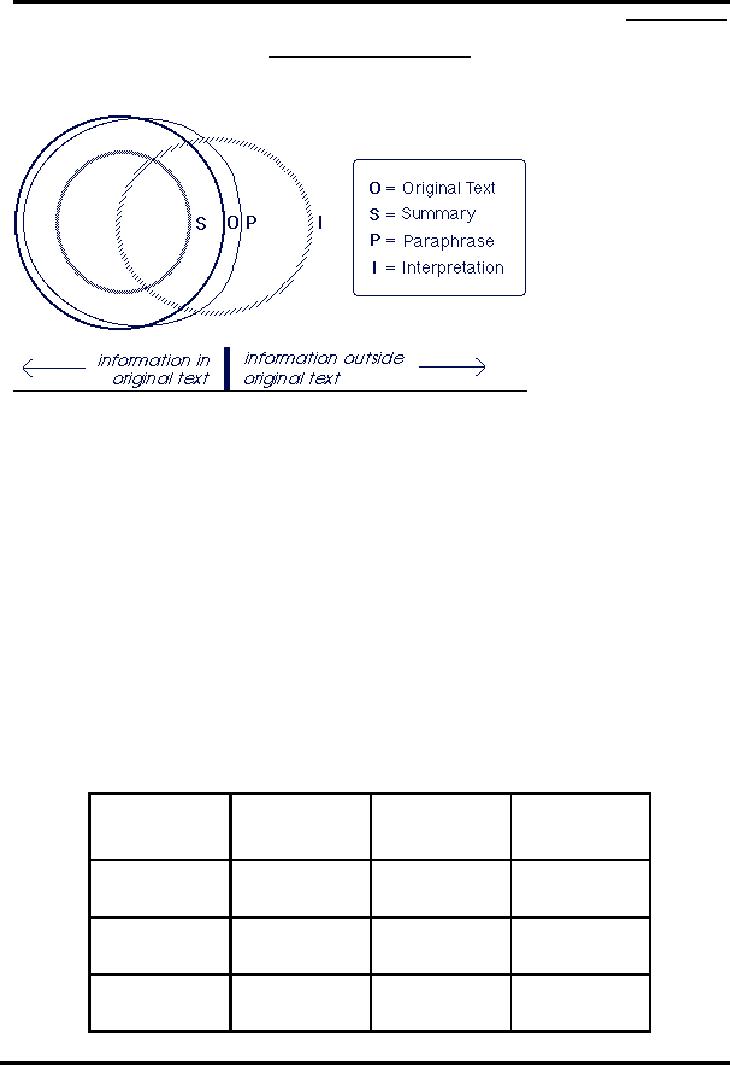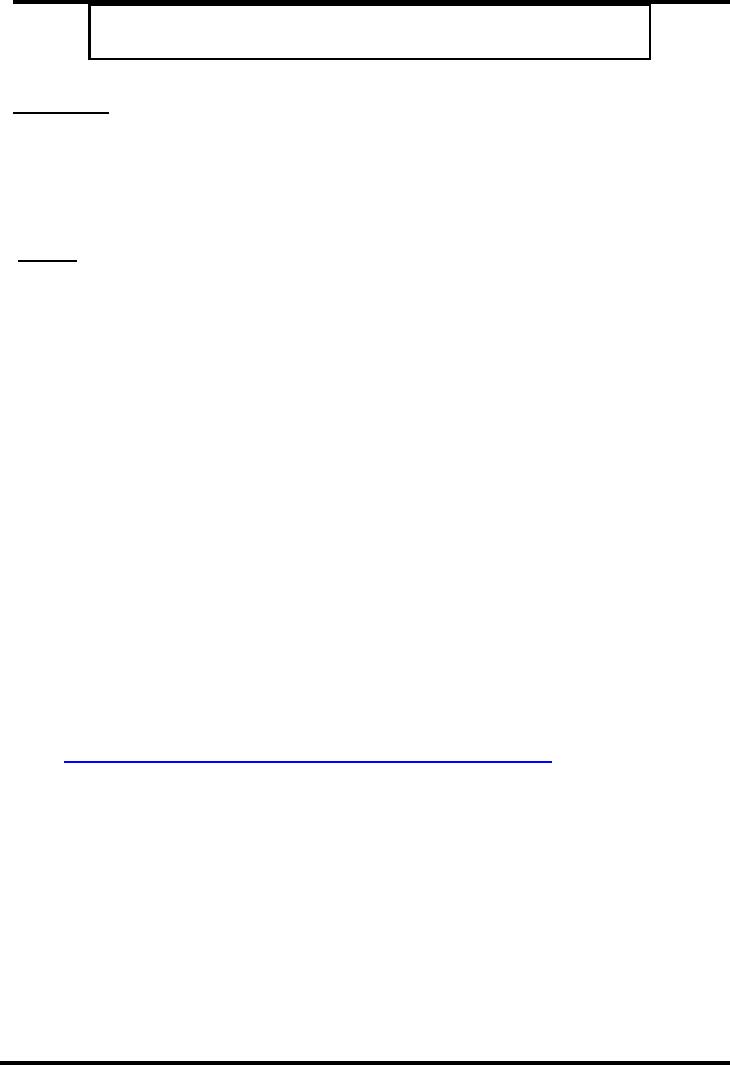 |
Summary and Précis Writing:CHARACTERISTICS OF GOOD SUMMARY |
| << RESEARCH WRITING AND DOCUMNETING SOURCES:Handling Long Quotations |
| Punctuation:THE PERIOD, THE COMMA, THE SEMICOLON, THE COLON >> |

Journalistic
Writing MCM310
VU
LECTURE
28
Summary
and Pr�cis Writing
A
graphic representation of the differences
between summaries, paraphrases,
and interpretations
A
summary is an
abridgement expressing the main
ideas of a text passage
through reported speech.
A
successful
summary is not an exposition of the
writer's own opinions, but a
distillation of the essential points
in
an
original
text.
Three
points should be kept in
mind:
(1)
summaries are shorter than
original texts,
(2)
they contain the main ideas of a text,
and
(3)
They are in reported speech.
A
paraphrase attempts
to express the same ideas of an
original text in different
words. Different wordings
naturally
result in slightly different
shades of meaning. However,
successful paraphrases achieve
nearly the
same
meaning as an original text. No attempt
at brevity is made in paraphrasing.
Indeed, if extensive
circumlocution
is used, a paraphrase may be longer than
its original text.
An
interpretative critique evaluates
some (or all) of the issues
raised in a text. Successful
interpretative
critiques
offer new critical perspectives
regarding some (or all) of the
ideas stated in an original
passage by
introducing
information outside of the original
text passage.
Reported
Speech?
Length?
Genre
Information
outside
or original
text?
1.
Summary
No
Yes
Shorter
than original
text
2.
Paraphrasing
Yes
No
(unless in original Yes and
No (both
text)
possible)
3.Interpretative
Yes
No
Any
length possible
critique
105

Journalistic
Writing MCM310
VU
Figure
2 - A cloze
diagram contrasting three
writing genres
For
Example:
Original
Text
I
am a Taiwanese man, but I
have lived in Canada for
several years now. I am
surprised at how
Canadian
society
respects the rights of women, both at
work and home. Personally I
believe women in Canada are
better
off
than women in Taiwan.
However, some of my female friends in
Canada miss the good old
days when
women
were treated in a different
ways. You see, in the past,
gentlemen followed different
rules of behavior.
They
would open the doors for
ladies, pull out chairs
for ladies to sit down,
stand up when a lady left the
table,
and
offer to pay the bill at
restaurants. Now, however, most
Canadian believes that men
and women should be
considered
equal. For example, women
now generally have to pay
for their own
meals.
[133
words From Ming Chuan
University PE5
Examination, autumn 2000 Day
Version]
Summary
This
text describes the experience of a
Taiwanese man who has
lived in Canada for several
years. He considers
Canadian
women better off than
Taiwanese. However, he notes
some Canadian women feel
nostalgic about the
days
when they received special courtesies.
For example, formerly men
opened doors for women or
paid for
their
meals. At this time, most Canadians
endeavor to treat men and
women equally. Women today
therefore
are
expected to cover the cost of
their own meals.
[78
words]
Paraphrase
I'm
Taiwanese and have lived in
Canada for several years.
The way Canadians respect
women's rights, both at
work
and home, is surprising. My
opinion is that Canadian
women are better off than
Taiwanese. Some women
in
Canada whom I know miss the
days when they were treated
differently. Behavior standards differed
in the
past.
At one time, men opened
doors for women, pulled
out chairs for them,
and offered to pay their
bills
when
dining out. Now, however,
most Canadians believe men
and women should be regarded as
equals. As a
result,
women now must generally
pay for their own
meals. [103
words]
Interpretative
Critique
I
think that men and
women should be treated equally. In
Taiwan this is rarely the case, so in
many ways
Canadian
women are luckier than
Taiwanese. Though men often
pay for women's meals in
Taiwan, they also
earn
more than women, which is
unfair. Most women
appreciate courtesies such as having
doors opened for
them.
However, a more pressing
need is gender equality - especially in
the workplace. Men and women
doing
the
same work should get the
same pay. In the future, I hope
Taiwanese women will have
the same rights as
Canadian
women. [95
words]
CHARACTERISTICS
OF GOOD SUMMARY:
Source:
http://www.sdc.uwo.ca/writing/handouts/Summary%20Writing.pdf
A
good summary has the
following characteristics:
Proper
Citation: The
summary begins by citing the
title, author, source, and,
in the case of a magazine or
journal
article, the date of publication
and the text.
Thesis
Statement: The
overall thesis of the text
selection is the author's central theme.
There are several
aspects
to an effective thesis statement:
-
It comprises two
parts:
a)
The topic or general subject
matter of the text,
and
b)
The author's major assertion, comment, or
position on the topic.
-
This central theme is summarized
clearly and accurately in a
one sentence thesis
statement
-
The thesis statement does
not contain specific details
discussed in the text
106

Journalistic
Writing MCM310
VU
-
The thesis statement is
stated at the beginning of the
summary.
Supporting
Ideas: The
author supports his/her
thesis with supporting
ideas. Use the following
basic
guidelines
when summarising supporting
ideas:
-
Cover all of the author's major supporting
ideas.
-
Show the relationships among these
ideas.
-
Omit specifics, such as illustrations,
descriptions, and detailed
explanations.
-
Indicate the author's purpose in writing:
to inform, to persuade, or to entertain. If the
passage is a persuasive
piece,
report the author's bias or position on
the issue.
-
Omit all personal opinions,
ideas, and inferences. Let
the reader know that you
are reporting the author's
ideas.
Grammar
and the Mechanics of Writing: Grammar
and related concerns ensure
that, as a writer, you
communicate
clearly to your reader. The
following are particularly
important:
-
Restate the ideas in your
own words as much as
possible. Avoid direct quotations.
-
Use transitional words for a smooth
and logical flow of
ideas.
-
Edit and re-write your
work.
-
Check your grammar,
punctuation, and spelling
Length:
The
length of a summary depends on
how long the original document
is.
STEPS
IN WRITING A SUMMARY:
Initially,
summary writing can seem
like a challenging task. It
requires careful reading and
reflective thinking
about
the article. Most of us, however,
tend to skim read without
focused reflection, but with
time and effort,
the
steps listed here can help
you become an effective summary
writer.
Read
the article
Reread
the Article.
-
Divide the article into
segments or sections of ideas.
Each segment deals with
one aspect of the
central
theme.
A segment can comprise one
or more paragraphs. Note:
news magazine articles tend
to begin with an
anecdote.
This is the writer's lead into the
article, but does not
contain the thesis or supporting
ideas.
Typically,
a feature lead does not
constitute a segment of thought.
-
Label each segment. Use a
general phrase that captures
the subject matter of the segment.
Write the label in
the
margin next to the
segment.
-
Highlight or underline the main
points and key
phrases.
Write
One-Sentence summaries.
-
Write a one-sentence summary
for each segment of thought
on a separate sheet of paper.
Formulate
the Thesis
Statement.
-
Formulate a central theme that
weaves the one-sentence segment
summaries together. This is your
thesis
statement.
-
In many articles, the author
will state this directly.
You may wish to take
his direct statement of the thesis
and
restate
it in your own words. Note:
In news magazine articles, the
thesis is often suggested
through the
article's
title and sub-title.
107

Journalistic
Writing MCM310
VU
-
In other articles, you may
have to write your own
one-sentence thesis statement
that summarizes this
central
theme.
Write
Your First Draft.
-
Begin with a proper citation of the
title, author, source, and
date of publication of the article
summarised.
-
Combine the thesis statement and
your one-sentence segment
summaries into a
one-to-two-paragraph
summary.
-
Eliminate all unnecessary
words and repetitions.
-
Eliminate all personal ideas
and inferences.
-
Use transitions for a smooth and logical
flow of ideas.
-
Conclude with a "summing up"
sentence by stating what can be
learned from reading the
article.
Edit
Your Draft. Check
your summary by asking the
following questions:
-
Have I answered who, what,
when, why, and how
questions?
-
Is my grammar, punctuation, and spelling
correct?
-
Have I left out my personal
views and ideas?
-
Does my summary "hang together"?
Does it flow when I read it
aloud?
-
Have someone else read
it. Does the summary give them the
central ideas of the
article?
Write
Your Final Draft.
Example:
Original
Passage I:
Height
connotes status in many
parts of the world. Executive offices are
usually on the top floors;
the
underlings
work below. Even being tall
can help a person succeed.
Studies have shown that
employers are
more
willing to hire men over 6
feet tall than shorter men
with the same credentials.
Studies of real-world
executives
and graduates have shown
that taller men make more
money. In one study, every extra
inch of
height
brought in an extra $1,300 a
year. But being too big
can be a disadvantage. A tall, brawny
football player
complained
that people found him
intimidating off the field
and assumed he "had the
brains of a Twinkie." (p.
301)
---Locker,
K. O. (2003). Business
and administrative communication
(6th
Ed) St. Louis, MO:
Irwin/McGraw-Hill.
Let's
first identify the main
points in the original
passage.
Topic
sentence: "Height
connotes status in many
parts of the world."
Main
point: "Even
being tall can help a person
succeed."
Main
point: "Executive
offices are usually on the
top"
Main
point: "being
too big can be a
disadvantage"
For
this example, we'll look at
multiple summaries. As you
read the sample summaries
below determine if the
main
points were included and if the
unimportant points were
discarded.
Also
check to see if both wording
and sentence structure do
not follow those of the
original.
Summary
A:
Throughout
the world, being tall will
lead to professional success. In
fact, research shows that
employers are
more
likely to hire taller men
and to pay them more, as
compared to shorter men with the
same qualifications
(Locker,
2003).
108

Journalistic
Writing MCM310
VU
[This
summary is too brief.
Further, it changes the meaning
slightly, giving the impression
that being tall
guarantees
success.]
Summary
B:
In
most countries, height
suggests status. For
instance, higher executives normally
use top floors of
office
buildings.
Further, research shows that
men over six feet tall
are more likely to be hired
than those shorter
than
them
but with the same qualifications.
Taller men also receive
greater incomes, possibly as
much as $1,300 a
year
more than that only
one inch shorter than them.
However, as a tall and
muscular football player
points
out,
a disadvantage to being tall is that
some individuals may
perceive you as threatening or even
dumb
(Locker,
2003).
[This
summary is too long. Instead of
focusing on the main points, it includes
all of the details that are
in the
original
passage.]
Summary
C:
Though
height may connote slowness to
some people, in the business
world, it is almost universally
associated
with
success. For example, taller
men are more likely to be
hired and to have greater
salaries. Further, those
in
top
positions within a company are
more likely to work on the
top floors of office
buildings (Locker,
2003).
[This
summary is the most effective. In
addition to including all of the
main points, it leaves out
the
unimportant
details.]
Source:
http://www.sdc.uwo.ca/writing/handouts/Summary%20Writing.pdf
ELJ
Journal, Vol.
2, No. 2. Fall 2001 (p.
1)
109
Table of Contents:
- INTRODUCTION TO JOURNALISTIC WRITING:Practical, THINGS TO KNOW
- QUALITIES OF GOOD WRITERS
- QUALITIES OF GOOD WRITERS
- QUALITIES OF GOOD WRITING:Achieve appropriate readability:
- QUALITIES OF GOOD WRITING:Be concise, Be creative, Be correct
- THE PROCESS OF WRITING:INVENTION, WHEN YOU START TO WRITE
- THE PROCESS OF WRITING II:ORGANIZING, DRAFTING, REVISING
- ALL ABOUT WORDS:HOW WORDS ARE FORMED?:SUFFIXES
- DICTIONARY-A WRITER’S LANGUAGE TOOL:KINDS OF INFORMATION
- PARTS OF SPEECH:Noun Gender, Noun Plurals, Countable Nouns
- BASIC CLAUSE PATTERNS
- ACTIVE AND PASSSIVE VOICE
- MODIFIERS AND SENTENCE TYPES:COMPOUND SENTENCES
- REPORTED SPEECH:Indirect Questions, Direct commands
- GRAMMATICAL SENTENCE – ISSUES:SUBJECT-VERB AGREEMENT
- GRAMMATICAL SENTENCE – ISSUES II:SENTENCE FRAGMENTS
- EFFECTIVE SENTENCE:PARALLELISM, NEEDED WORDS, SHIFTS
- STYLE: GUIDELINE AND PITFALLS I:COLLOQUIAL VS FORMAL, CIRCUMLOCUTION
- STYLE: GUIDELINE AND PITFALLS II:AMBIGUITY, REDUNDANCY, EUPHEMISM:
- PARAGRAPH WRITING: TYPES AND TECHNIQUES:STRUCTURE
- PARAGRAPH WRITING: TYPES AND TECHNIQUES:Putting on Our Play
- ESSAY WRITING:VARIOUS STRATEGIES FOR ESSAYS, PROMPTS
- SIGNAL WORDS:Non word Emphasis Signals
- EXPOSITORY WRITING:LOGICAL FALLACIES, APPEAL TO EMOTION
- THE WRITING STYLES: REPORT and NARRATIVE WRITING, SHORT REPORTS
- THE WRITING STYLES: DESCRIPTIVE AND PERSUASIVE WRITINGS, Observation
- RESEARCH WRITING AND DOCUMNETING SOURCES:Handling Long Quotations
- Summary and Précis Writing:CHARACTERISTICS OF GOOD SUMMARY
- Punctuation:THE PERIOD, THE COMMA, THE SEMICOLON, THE COLON
- MECHANICS:ABBREVIATIONS, NUMBERS, SPELLING, THE HYPHEN
- READING SKILLS FOR WRITERS:EDUCATED READING, STEPS
- PARTS OF A NEWSPAPER:Box-out, By-line, Caption, Exclusive, Feature
- THE LANGUAGE OF THE NEWSPAPERS II:BROADSHEET NEWSPAPER
- News Writing and Style I:WHAT TO LOOK FOR IN A NEWSPAPER
- NEWS WRITING II:Accuracy, Clarity, Style, Qualities of Effective Leads
- EDITORIAL WRITING:WRITING AN EDITORIAL:STRUCTURING AN EDITORIAL
- WRITING FEATURES:GENERATING FEATURE STORY IDEAS
- WRITING COLUMNS:Column and a news report, Purpose, Audience
- WRITING ARTICLES FOR NEWSPAPERS:The Heading, The Lead
- WRITING ANALYSIS:purpose, scope, method, results, recommendations
- LETTERS TO EDITORS:Four important aspects about letters, Organizing letters
- BROADCAST AND WEB NEWS WRITING:WRITE CONCISELY, BROADCAST STYLE
- WRITING PRESS RELEASE, REVIEWS AND OBITUARIES:Summary of Content:
- THE ART OF INTERVIEWINGS
- FINAL THOUGHTS:Practical, Job-Related, Social, Stimulating, Therapeutic